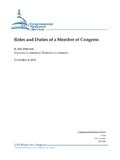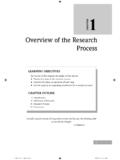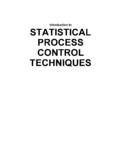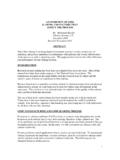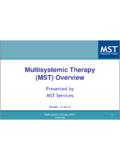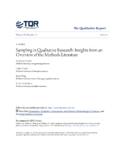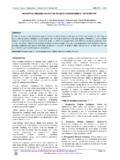Transcription of A Brief Overview of Rulemaking and Judicial Review
1 CRS Report for CongressPrepared for Members and Committees of Congress A Brief Overview of Rulemaking and Judicial Review Vanessa K. Burrows Legislative Attorney Todd Garvey Legislative Attorney January 4, 2011 Congressional research Service7-5700 R41546 .c11173008A Brief Overview of Rulemaking and Judicial Review Congressional research Service Summary The Administrative Procedure Act (APA), which applies to all agencies, provides the general procedures for various types of Rulemaking . The APA details the rarely used procedures for formal rules as well as the requirements for informal Rulemaking , under which the vast majority of agency rules are issued. This report provides a Brief legal Overview of the various methods by which agencies may promulgate rules, which include formal Rulemaking , informal (notice-and-comment or 553) Rulemaking , hybrid Rulemaking , direct final Rulemaking , and negotiated Rulemaking .
2 There is substantial case law regarding APA procedures and agency rulemakings. This report concisely mentions the standards that reviewing courts will use to discern whether agency rules have been validly promulgated. Additionally, inquiries regarding the APA often concern agency actions that involve exceptions to APA requirements or additional steps that agencies voluntarily have taken or imposed upon themselves that are not required by the APA. For example, adversely affected parties may contest agency uses of the good cause exceptions to the APA procedural requirements to promulgate an interim final rule. Another frequent topic of inquiry is whether an agency guidance document should have been issued as a legislative rule under APA notice-and-comment procedures. This report does not address the requirements of presidential Review of agency Rulemaking under Executive Order 12866 or other statutes that may impact particular agency rulemakings, such as the Regulatory Flexibility Act, the National Environmental Policy Act, the Congressional Review Act, or the Unfunded Mandates Reform Act.
3 Additionally, issues of standing, ripeness, finality of agency action, or exhaustion of administrative remedies may arise. As this Brief report does not address these potentially applicable statutes or legal issues in depth, the authors may assist with legal questions regarding such requirements or agency-specific rules..A Brief Overview of Rulemaking and Judicial Review Congressional research Service Contents Introduction .. 1 Types of Rulemaking .. 1 Informal/Notice-and-Comment/ 1 Formal .. 3 Hybrid .. 3 Direct 4 Negotiated .. 4 Exceptions to the APA s 553 Rulemaking 5 Wholly Exempt .. 5 Exceptions to the Notice-and-Comment Procedures .. 6 Exceptions to the 30-Day Delayed Effective Date .. 9 Judicial 9 Contacts Author Contact Information ..11 .A Brief Overview of Rulemaking and Judicial Review Congressional research Service 1 Introduction The Administrative Procedure Act (APA) applies to all executive branch agencies, including so-called independent regulatory The APA prescribes procedures for agency actions such as Rulemaking , as well as standards for Judicial Review of agency Rulemaking is the agency process for formulating, amending, or repealing a rule, 3 where a rule is defined as an agency statement of general or particular applicability and future effect designed to implement, interpret, or prescribe law or policy or describing the organization, procedure, or practice requirements of an agency.
4 4 This report provides a Brief legal Overview of APA Rulemaking . Types of Rulemaking Federal agencies may promulgate rules through various methods. Although the notice-and-comment Rulemaking procedures of 553 of the APA represent the most commonly followed process for issuing legislative rules, agencies may choose or may be required to use other Rulemaking options, including formal, hybrid, direct final, and negotiated Rulemaking . The method by which an agency issues a rule may have significant consequences for both the procedures the agency is required to undertake and the deference with which a reviewing court will accord the rule. In addition, the APA contains whole or partial exceptions to the statute s otherwise applicable Rulemaking requirements. Informal/Notice-and-Comment/ 553 Generally, when an agency promulgates legislative rules, or rules made pursuant to congressionally delegated authority, the exercise of that authority is governed by the informal Rulemaking procedures outlined in 5 In an effort to ensure public participation in the informal Rulemaking process , agencies are required to provide the public with adequate notice of a proposed rule followed by a meaningful opportunity to comment on the rule s Although the APA sets the minimum degree of public participation the agency must permit, [matters] of great importance, or those where the public submission of facts will be either useful to the agency or a protection to the public, should naturally be accorded more elaborate public procedures.
5 7 1 5 551(a). 2 5 551(a), 701-06. Under the Clean Air Act, Congress removed certain Environmental Protection Agency Rulemaking activities from the APA s coverage and instead established a separate set of similar procedures that the agency must follow in promulgating specific rules and regulations. See, Clean Air Act 307(d) (codified at 42 7607(d)). 3 5 551(5). 4 5 551(4). For a non-legal discussion of federal Rulemaking , see CRS Report RL32240, The Federal Rulemaking process : An Overview , by Curtis W. Copeland. 5 5 553. 6 5 553 (b)-(c). 7 Administrative Procedure Act: Legislative History, S. Doc. No. 248, at 259 (1946); CHARLES H. KOCH JR., 1 ADMINISTRATIVE LAW AND PRACTICE 329-30 (2010 ed.)..A Brief Overview of Rulemaking and Judicial Review Congressional research Service 2 The requirement under 553 to provide the public with adequate notice of a proposed rule is generally achieved through the publication of a notice of proposed Rulemaking in the Federal The APA requires that the notice of proposed Rulemaking include (1) the time, place, and nature of public Rulemaking proceedings; (2) reference to the legal authority under which the rule is proposed; and (3) either the terms or substance of the proposed rule or a description of the subjects and issues involved.
6 9 Generally speaking, the notice requirement of 553 is satisfied when the agency affords interested persons a reasonable and meaningful opportunity to participate in the Rulemaking process . 10 Once adequate notice is provided, the agency must provide interested persons with a meaningful opportunity to comment on the proposed rule through the submission of written data, views, or arguments. 11 The comment period may result in a vast Rulemaking record as persons are permitted to submit nearly any piece of information for consideration by the agency. While there is no minimum period of time for which the agency is required to accept comments, in reviewing an agency Rulemaking , courts have focused on whether the agency provided an adequate opportunity to comment of which the length of the comment period represents only one factor for Once the comment period has closed, the APA directs the agency to consider the relevant matter presented and incorporate into the adopted rule a concise general statement of the basis and purpose of the final The general statement of basis and purpose should enable the public to obtain a general idea of the purpose of, and a statement of the basic justification for, the rules.
7 14 The final rule, along with the general statement must be published in the Federal Register not less than 30 days before the rule s effective 8 5 553(b). Such publication, however, is not strictly required where interested parties are identified and have actual notice. 5 553(b). Other exceptions to the publication requirement include an agency s use of the good cause exception, and if the rule is an interpretive rule[], general statement[] of policy, or rule[] of agency organization, procedure, or practice. Id. 9 5 553(b)1-3. 10 See, , Forester v. Consumer Product Safety Commission, 559 774, 787 ( Cir. 1977). 11 5 553(c). 12 JEFFREY S. LUBBERS, A GUIDE TO FEDERAL AGENCY Rulemaking 296 (4th ed. 2006) (citing Fla. Power & Light Co. v. , 846 765, 772 ( Cir. 1988)). However, some statutes require minimum comment periods.
8 See, , 42 6295(p)(2). Additionally, Executive Order 12866, which provides for presidential Review of agency Rulemaking via the Office of Management and Budget s Office of Information and Regulatory Affairs, states that the public s opportunity to comment, in most cases should include a comment period of not less than 60 days. Exec. Order No. 12866, 6(a), 58 Fed. Reg. 51735 (Oct. 4, 1993). This portion of Executive Order 12866 does not apply to independent regulatory agencies. Id. at 3(b). 13 5 553(c). 14 Administrative Procedure Act: Legislative History, S. Doc. No. 248, at 225 (1946). In practice such statements tend to be lengthy preambles to the final rules, which agencies use to advise interested persons how the rule will be applied, to respond to questions raised by comments received during the Rulemaking , and as a legislative history that can be referred to in future applications of the rule, as well as by reviewing courts.
9 LUBBERS, supra note 12, at 376. 15 The APA does, however, create three exceptions (discussed infra) to the 30-day advanced publication requirement. 5 553(d)1-3. If a final rule that is subject to the 30-day requirement is not published in the Federal Register, a person may not be adversely affected by the unpublished rule unless the person has actual and timely notice of the rule s terms. 5 552(a)(1)..A Brief Overview of Rulemaking and Judicial Review Congressional research Service 3 Formal Although rules are typically promulgated through the informal Rulemaking process , in limited circumstances, federal agencies must follow formal Rulemaking requirements. Under the APA, when rules are required by statute to be made on the record after opportunity for an agency hearing the formal Rulemaking requirements of 556 and 557 The Supreme Court has interpreted this language very narrowly, determining that formal Rulemaking requirements are only triggered when Congress explicitly requires that the Rulemaking proceed on the record.
10 17 When formal Rulemaking is required, the agency must engage in trial-like procedures. The agency, therefore, must provide a party with the opportunity to present his case through oral or documentary evidence and conduct such cross-examination as may be required for a full and true disclosure of the facts. 18 Formal Rulemaking proceedings must be presided over by an agency official or Administrative Law Judge who traditionally has the authority to administer oaths, issue subpoenas, and exclude irrelevant, immaterial, or unduly repetitious evidence. 19 Formal Rulemaking procedures also prohibit ex parte communications between interested persons outside the agency and agency officials involved in the Rulemaking The agency or proponent of the rule has the burden of proof, and such rules must be issued on consideration of the whole record .. and supported by .. substantial evidence. 21 Hybrid In providing Rulemaking authority to an agency, Congress may direct the agency to follow specific procedural requirements in addition to those required by the informal Rulemaking procedures of the APA.
